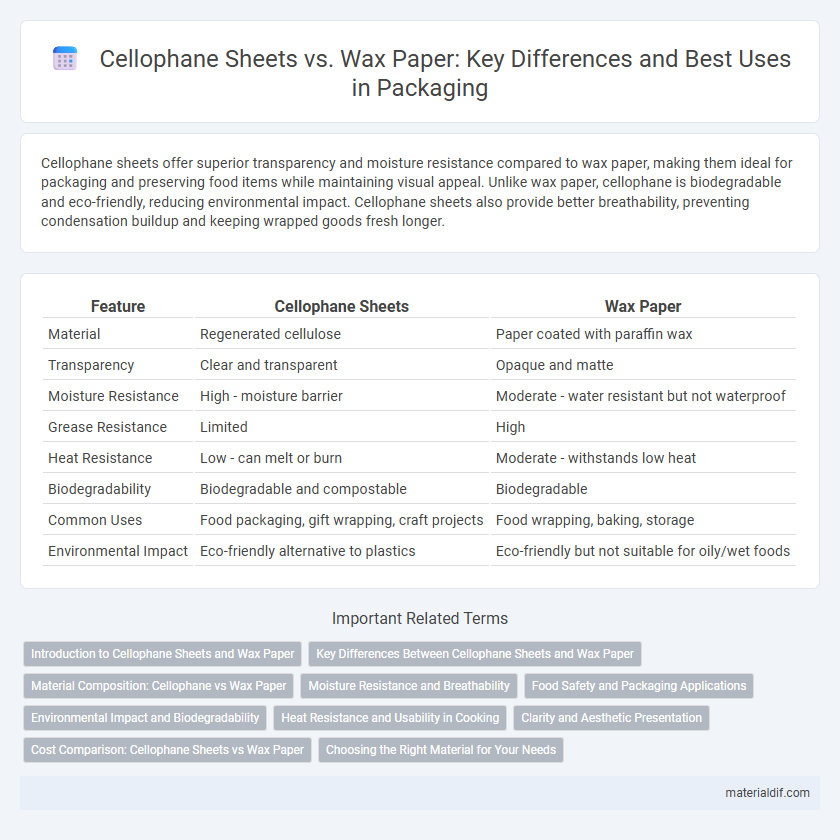Cellophane sheets offer superior transparency and moisture resistance compared to wax paper, making them ideal for packaging and preserving food items while maintaining visual appeal. Unlike wax paper, cellophane is biodegradable and eco-friendly, reducing environmental impact. Cellophane sheets also provide better breathability, preventing condensation buildup and keeping wrapped goods fresh longer.
Table of Comparison
| Feature | Cellophane Sheets | Wax Paper |
|---|---|---|
| Material | Regenerated cellulose | Paper coated with paraffin wax |
| Transparency | Clear and transparent | Opaque and matte |
| Moisture Resistance | High - moisture barrier | Moderate - water resistant but not waterproof |
| Grease Resistance | Limited | High |
| Heat Resistance | Low - can melt or burn | Moderate - withstands low heat |
| Biodegradability | Biodegradable and compostable | Biodegradable |
| Common Uses | Food packaging, gift wrapping, craft projects | Food wrapping, baking, storage |
| Environmental Impact | Eco-friendly alternative to plastics | Eco-friendly but not suitable for oily/wet foods |
Introduction to Cellophane Sheets and Wax Paper
Cellophane sheets are transparent, cellulose-based films commonly used for packaging due to their moisture-resistant and breathable properties. Wax paper is coated with a thin layer of paraffin wax, making it water-resistant but not heat-resistant or suitable for direct contact with high temperatures. Cellophane provides a glossy, more durable barrier ideal for preserving freshness, while wax paper is typically used for wrapping and preventing food from sticking.
Key Differences Between Cellophane Sheets and Wax Paper
Cellophane sheets are made from regenerated cellulose and are transparent, breathable, and moisture-resistant, making them ideal for wrapping foods and gifts without trapping moisture. Wax paper is coated with a thin layer of paraffin wax, providing a non-stick, moisture-proof surface primarily used for baking and food preparation. Unlike wax paper, cellophane is biodegradable and environmentally friendly, whereas wax paper is less suitable for high-heat applications due to its low melting point.
Material Composition: Cellophane vs Wax Paper
Cellophane sheets are made from regenerated cellulose derived from wood pulp or cotton fibers, offering a biodegradable and transparent film with excellent oxygen and moisture barrier properties. Wax paper is composed of regular paper coated with paraffin wax or soybean-based wax, providing a water-resistant surface but limited grease resistance and lower breathability compared to cellophane. The cellulose base of cellophane ensures eco-friendly disposability and clarity, while wax paper's wax coating offers flexibility in moisture protection but lacks transparency and biodegradability.
Moisture Resistance and Breathability
Cellophane sheets offer superior moisture resistance compared to wax paper, making them ideal for preserving freshness in food packaging by preventing water vapor penetration. Unlike wax paper, which is coated with a thin layer of wax that allows some breathability, cellophane provides an effective barrier that limits both moisture and air exchange. This combination of moisture resistance and limited breathability helps maintain product quality and extends shelf life.
Food Safety and Packaging Applications
Cellophane sheets offer superior breathability and moisture resistance compared to wax paper, making them ideal for packaging fresh produce and baked goods while maintaining food safety standards. Unlike wax paper, which can sometimes transfer waxy residues and is less effective at preventing air exposure, cellophane provides a clear, non-toxic barrier that ensures product freshness without compromising taste or hygiene. These properties make cellophane sheets a preferred choice in commercial food packaging where transparency and contamination prevention are critical.
Environmental Impact and Biodegradability
Cellophane sheets, made from cellulose derived from wood pulp, are biodegradable and compostable, breaking down naturally in the environment within weeks to months. In contrast, wax paper is typically coated with paraffin wax, a petroleum-based product that does not biodegrade easily and can persist in landfills for years. Choosing cellophane reduces plastic waste and supports sustainable environmental practices due to its renewable material source and natural decomposition process.
Heat Resistance and Usability in Cooking
Cellophane sheets offer higher heat resistance compared to wax paper, making them suitable for wrapping hot foods or lining baking trays without melting or releasing harmful fumes. Wax paper, coated with paraffin wax, tends to melt or smoke under high temperatures, limiting its use to cold food storage or low-heat applications. For cooking tasks requiring exposure to heat, cellophane sheets provide durability and safety, whereas wax paper is better reserved for non-heat-related food preparation.
Clarity and Aesthetic Presentation
Cellophane sheets offer superior clarity compared to wax paper, making them ideal for showcasing food items while maintaining a visually appealing presentation. Unlike wax paper's opaque and slightly cloudy texture, cellophane provides a glossy, transparent finish that enhances the aesthetics of gift wrapping and food packaging. The high transparency of cellophane sheets ensures that colors and textures remain visible, boosting product appeal in retail and culinary applications.
Cost Comparison: Cellophane Sheets vs Wax Paper
Cellophane sheets generally cost more than wax paper due to their biodegradable, transparent material and specialized manufacturing process. Wax paper is typically less expensive, making it a budget-friendly option for everyday kitchen use. However, the durability and moisture resistance of cellophane sheets justify their higher price in packaging and decorative applications.
Choosing the Right Material for Your Needs
Cellophane sheets offer a transparent, biodegradable option ideal for wrapping food and gifts, while wax paper provides a moisture-resistant barrier suited for baking and cooking tasks. Consider cellophane for presentation and breathability, whereas wax paper excels in preventing sticking and protecting surfaces during heat exposure. Choosing between these materials depends on whether visibility and eco-friendliness or moisture resistance and heat tolerance are your primary concerns.
Cellophane Sheets vs Wax Paper Infographic

 materialdif.com
materialdif.com